From Ideas to Action: 5 Prompt Frameworks for Business Leaders
From executive summaries to brainstorming new ideas, prompt frameworks can make AI tools like ChatGPT more impactful. Explore 5 prompt engineering frameworks that help leaders get consistent results.
Prompt engineering frameworks reimagine vague AI prompts into clear, repeatable structures, defining context, role, task, and output, so leaders can get consistent, high‑quality results from AI tools like ChatGPT.
Prompt frameworks such as RISE, RTF, BAB, CARE, and CRIT give executives practical ways to apply AI prompts for decision‑making, executive summaries, board updates, and strategic planning.
By using structured AI prompts, business leaders can turn ChatGPT into a reliable thought partner that drives smarter decisions, sharper communication, and measurable productivity gains.
The way we interact with AI has changed thanks to the widespread adoption of large language models (LLMs) and AI tools like ChatGPT. Business leaders can now access insights, analysis, and support through clear prompts, eliminating the need for technical teams.
However, results often vary, and achieving consistent, high-quality output depends on more than just the prompt itself. It requires structure. This leads us to an important question: What is a prompt engineering framework? A prompt engineering framework is a structured approach to writing prompts for AI tools.
Frameworks aren’t a new concept in business. From a balanced scorecard to OKRs, they have helped leaders tackle complex problems, align teams, and make better decisions for decades. They are effective because they bring order, consistency, and a shared language to how organizations operate.
Prompt engineering frameworks apply that same principle to AI, turning it from an experimental tool into a reliable business partner. And the payoff can be substantial: research shows that AI tools like ChatGPT can boost workforce productivity by an average of 14%, with some companies reporting gains of up to 400%.
In this article, we’ll explore five practical prompt engineering frameworks that business leaders can use right away to get clearer, more consistent results from AI tools.
Choosing the Right Model for Better AI Prompts
LLMs are the engines behind today’s most advanced AI tools, and can directly affect how well your AI prompts perform. More advanced models can interpret context better, follow complex instructions more accurately, and deliver higher-quality, more reliable results.
For example, frontier models are the most advanced large language models available, capable of performing complex reasoning, generating high-quality content, and handling multimodal inputs. The three leading commercial frontier models are Google’s Gemini, OpenAI’s GPT-5, and Anthropic’s Claude. Gemini is known for its integration with Google’s ecosystem and multimodal capabilities.
Meanwhile, Claude is used as the backbone for most of the AI coding applications, and stands out for its strong safety features and long-form reasoning abilities. On the other hand, ChatGPT is continually evolving, with recent advancements including Agent mode and enhanced reasoning to handle more complex tasks.
The latest version of ChatGPT runs on GPT-5, delivering state-of-the-art performance in reasoning, writing, and problem-solving. GPT-5 adapts automatically to the complexity of each task, making it a versatile tool for both business and creative work. Many AI tools, such as Microsoft Copilot, are built on top of frontier models like GPT-5, extending these capabilities into everyday productivity.
In this article, we will be using ChatGPT prompt examples and leveraging GPT-5, OpenAI’s most advanced model. For non-coding scenarios, we recommend exploring the latest models from OpenAI, as GPT-5 can handle a wide range of tasks and seamlessly shift into a deeper reasoning or thinking mode when it encounters complex challenges, including those suited for Agent mode. This adaptability means GPT-5 can support various styles of AI prompts. Interestingly, there are countless ways to structure prompts depending on the task.
The vast range of AI prompt types makes it clear that prompt structure is the key to getting results that are consistent, reliable, and useful. A variety of prompt frameworks are already being used today.
Many of these prompt engineering frameworks are not entirely new. They often draw on best practices that have long existed in specific domains, such as research, communication, or process design. Over time, the AI community has adapted and refined these practices into frameworks that provide more general and repeatable approaches for working with large language models.
While we’ll discuss five of the most impactful prompt engineering frameworks next, you can also explore additional approaches with this custom ChatGPT tool: Framework Finder.
1. The RISE Prompt Framework (Role, Input, Steps, Expectation)
Let’s say there’s a CEO who needs a concise but meaningful summary of quarterly revenue performance. Instead of asking a tool like ChatGPT vaguely for “an analysis of the data,” they could apply the RISE framework. The RISE prompt framework stands for Role, Input, Steps, and Expectation.
It focuses on bringing structure and clarity to AI or ChatGPT prompts by making sure the LLM knows who it should act as, what information to work with, the logical process to follow, and the exact format of the response. This clarity reduces ambiguity and directs the LLM toward outputs that are both actionable and aligned with leadership needs.
Here’s how to apply the RISE framework:
- Role: Assign the AI model a specific role that matches the expertise required for the task, such as market strategist, financial analyst, or policy advisor.
- Input: Provide the most relevant and accurate information, organized in a way that is easy for the AI model to reference.
- Steps: Break down the process into logical, sequential actions that the AI model should follow to complete the task.
- Expectation: Specify exactly what the output should look like, including the format, style, and level of detail.
For example, the CEO might write: “You are a market strategist. Input: quarterly revenue data from North America and Europe. Steps: compare results with last quarter, identify growth patterns, and highlight risks. Expectation: provide a three‑point executive summary with recommendations for Q3.”
The RISE framework is best for tasks that follow a clear process and logical sequence. It’s well-suited for decision analysis to compare options, executive summaries that condense complex information, research synthesis that brings together findings from multiple sources, and structured reports with consistent formatting.
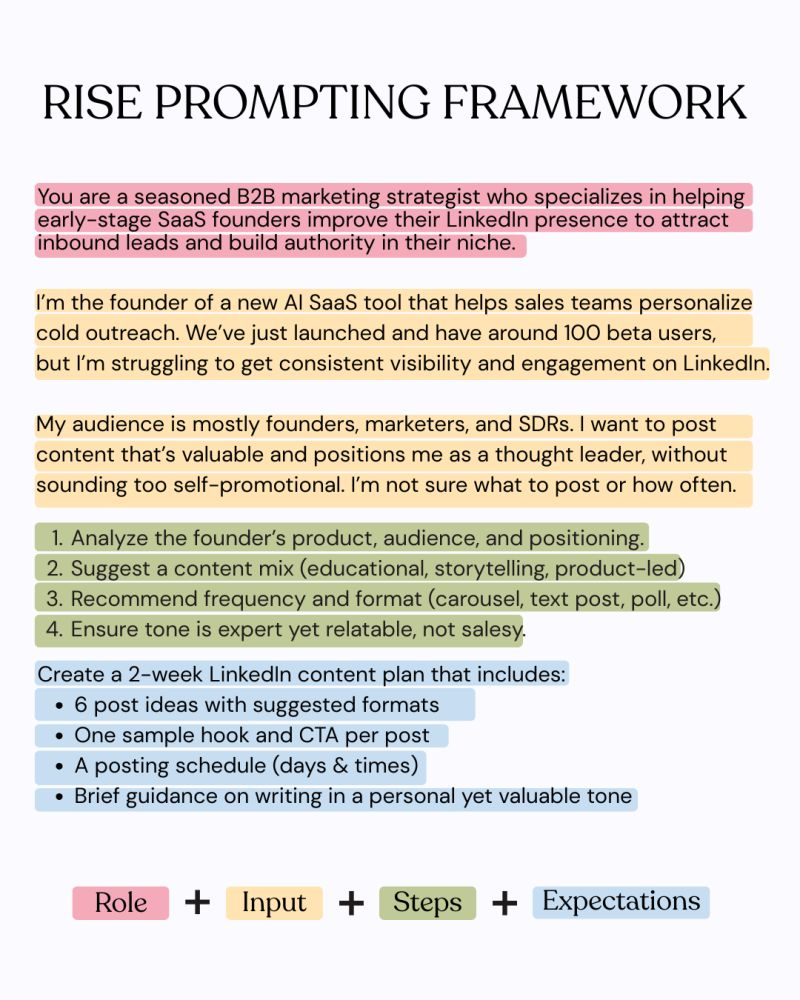
2. RTF Framework: Turning Vague Requests into Structured Insights
Consider a scenario where a CTO needs recommendations on how to strengthen the company’s cloud security practices. Instead of asking an AI tool vaguely for “ways to improve security,” the RTF framework (Role, Task, Format) provides a straightforward way to shape the request.
By defining the role the AI tool should adopt, the task it should perform, and the format the output should take, RTF ensures the response is clear, structured, and ready to use in an executive setting.
Here’s how to apply the RTF framework:
- Role: Clearly define the role the AI model should take on, such as cybersecurity consultant, financial analyst, or marketing strategist.
- Task: Describe exactly what you want the AI model to do, focusing on a specific, actionable request.
- Format: Specify the structure you want for the output, such as bullet points, a table, or a concise executive summary.
For instance, the CTO could prompt an LLM by writing: “You are a cybersecurity consultant. Task: recommend five strategies to improve our cloud security. Format: present them in a table with columns for initiative, benefit, and implementation effort.”
Using the RTF framework produces outputs that are practical, easy to understand, and ready for immediate use in decision-making. It works best for situations where leaders need concise, well-structured information they can act on quickly, such as preparing board updates, drafting executive reports, comparing options in table form, or summarizing recommendations for a leadership meeting.
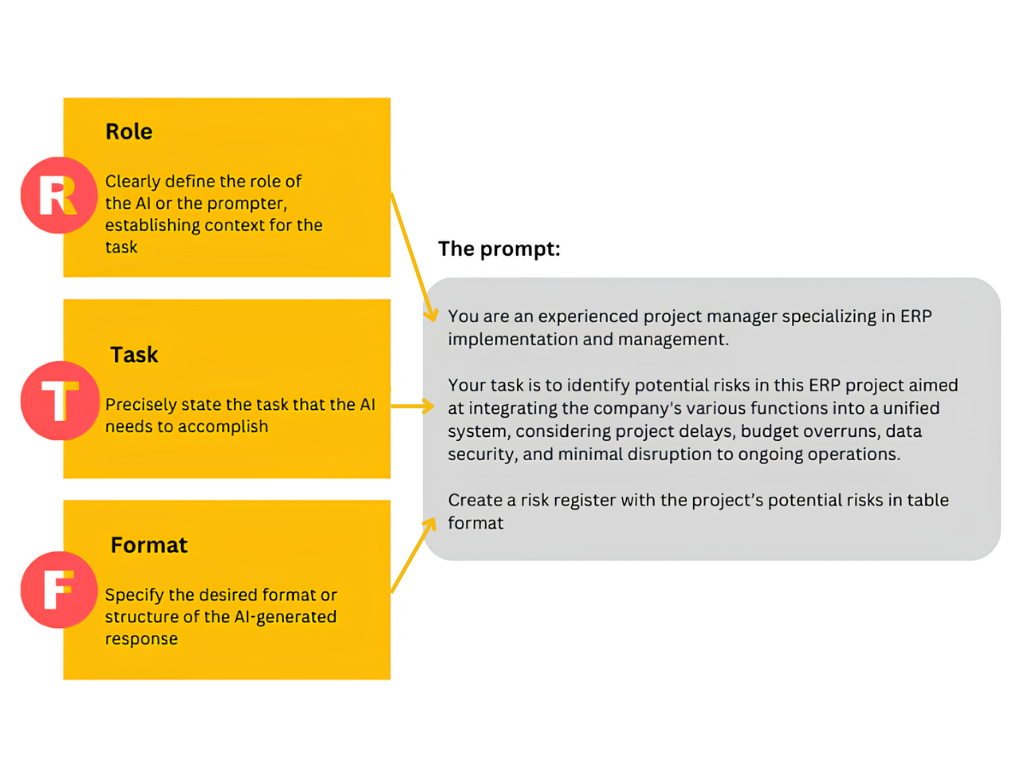
3. Telling a Story of Change With the BAB Framework
Setting goals and creating an actionable plan to work toward is a key part of leading a team. The BAB framework (Before, After, Bridge) makes it possible to frame prompts as a story of change. It asks the AI tool to describe the Before state (the current challenge), the After state (the improved outcome), and the Bridge (the path that connects the two).
Here’s how to apply the BAB framework:
- Before: Clearly describe the current situation or challenge so that the AI model has full context for the problem.
- After: Define the desired future state or outcome in specific, measurable terms.
- Bridge: Outline the actions, strategies, or steps that connect the current state to the desired outcome
For example, if a CFO is looking to communicate the benefits of a new cost‑management strategy, they could prompt: “Before: our operating expenses are rising faster than revenue. After: we achieve a leaner cost structure that improves profitability. Bridge: recommend three strategies to reduce expenses without affecting growth.” Instead of producing a generic list, the LLM is guided to create a persuasive narrative that highlights the challenge, envisions the solution, and lays out the steps to achieve it.
The BAB framework is perfect for communicating strategy, stakeholder presentations, and change‑management initiatives. By structuring prompts in this way, leaders can generate outputs that explain the need for change and show a clear path forward - making it easier to build alignment and drive action across their organizations.
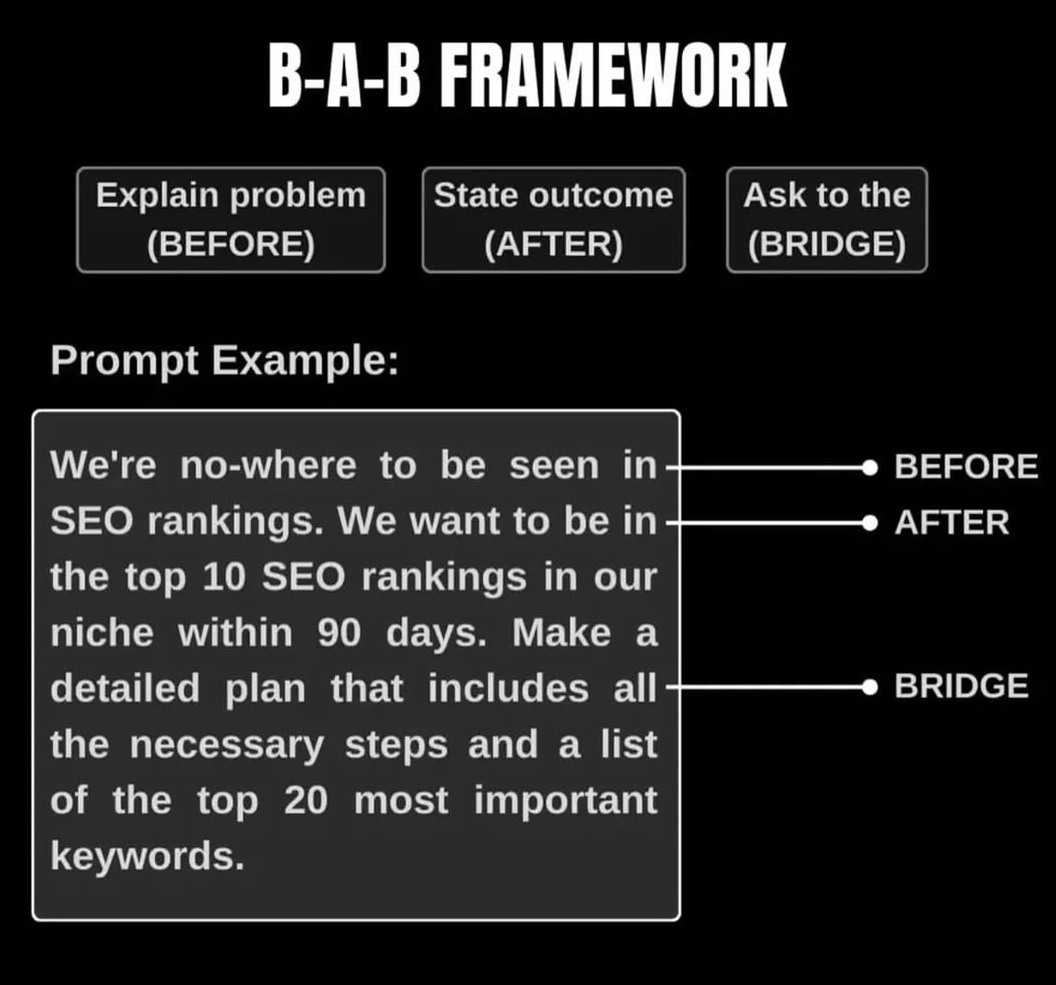
4. CARE: How Leaders Can Communicate Results with Clarity
Another prompt engineering framework that C‑level executives can depend on is CARE (Context, Action, Result, Example). It helps redefine prompts into structured narratives by letting the AI model consider the full picture: the Context behind the situation, the Action taken, the Result achieved, and a concrete Example to bring it to life.
Here’s how to apply the CARE framework:
- Context: Clearly describe the background or situation so that the AI model understands the environment in which the action is taking place.
- Action: Specify the steps or initiatives that were taken or should be taken to address the situation.
- Result: Define the measurable outcome or improvement that resulted or is expected from the action.
- Example: Provide a concrete case, story, or scenario that illustrates the result in a relatable way.
A Chief People Officer might prompt: “Context: our employee engagement survey showed low scores in remote collaboration. Action: outline a three-step initiative to introduce virtual mentoring and town halls. Result: improve engagement scores by 20% within six months. Example: highlight a team success story where engagement rose 30% after launch.” The output is a complete story that connects strategy to measurable results.
In general, the CARE prompt framework is particularly effective for case studies, project reviews, and situations where leaders need more than a summary - they need a compelling narrative. By organizing information into context, action, result, and example, CARE prompts let leaders illustrate not just what was done, but why it mattered and what impact it created. This makes it an insightful tool for presenting outcomes to boards, investors, or employees in a way that is clear, credible, and actionable.
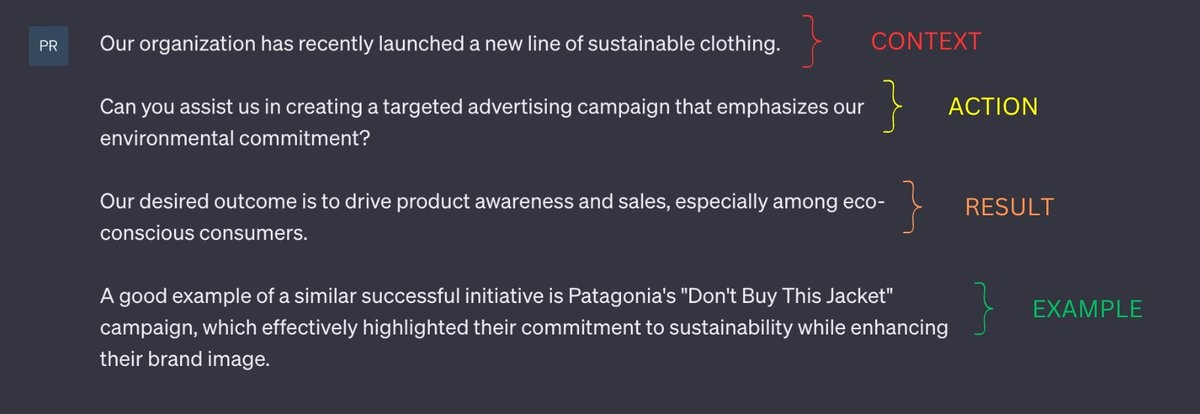
5. Turning AI Into a Boardroom Advisor with the CRIT Framework
So far, most of the frameworks we’ve seen don’t have a clear origin. The CRIT framework (Context, Role, Interview, Task) is different. It was developed by Geoff Woods, best‑selling author of The AI‑Driven Leader, to help executives get more strategic value from AI tools.
Woods created CRIT after realizing that traditional prompt examples treated AI like a passive assistant, when in fact it could act as a true thought partner. As he explains, “I realized it wasn't about asking AI questions, it was actually turning the tables and having AI ask me questions.”
CRIT works by guiding leaders through four deliberate steps: providing deep background information (Context), assigning a perspective or expertise (Role), allowing the AI to interview them with clarifying questions (Interview), and then defining the desired output (Task).
Here’s how to apply the CRIT framework:
- Context: Share detailed background information so the AI model fully understands the situation, stakeholders, and objectives.
- Role: Assign the AI model a specific perspective or expertise, such as board member, market strategist, or investor.
- Interview: Invite the AI model to ask clarifying questions before producing a final answer, ensuring it has all the necessary details.
- Task: Clearly define the output you want, including the deliverable type, scope, and format.
The CRIT prompt framework sharpens the quality of responses and mirrors the dynamics of a leadership advisory session. For example, Woods once used CRIT to simulate how a board of directors might react to a 60‑slide presentation. The AI correctly flagged a slide that would likely derail the discussion, allowing the CEO to refine the deck before the real meeting.
By reframing AI as a collaborative advisor, CRIT is especially great for executives preparing for board reviews, strategic planning sessions, or other high‑stakes decision‑making. It equips leaders with a way to uncover blind spots, stress‑test their thinking, and walk into critical meetings with greater confidence.
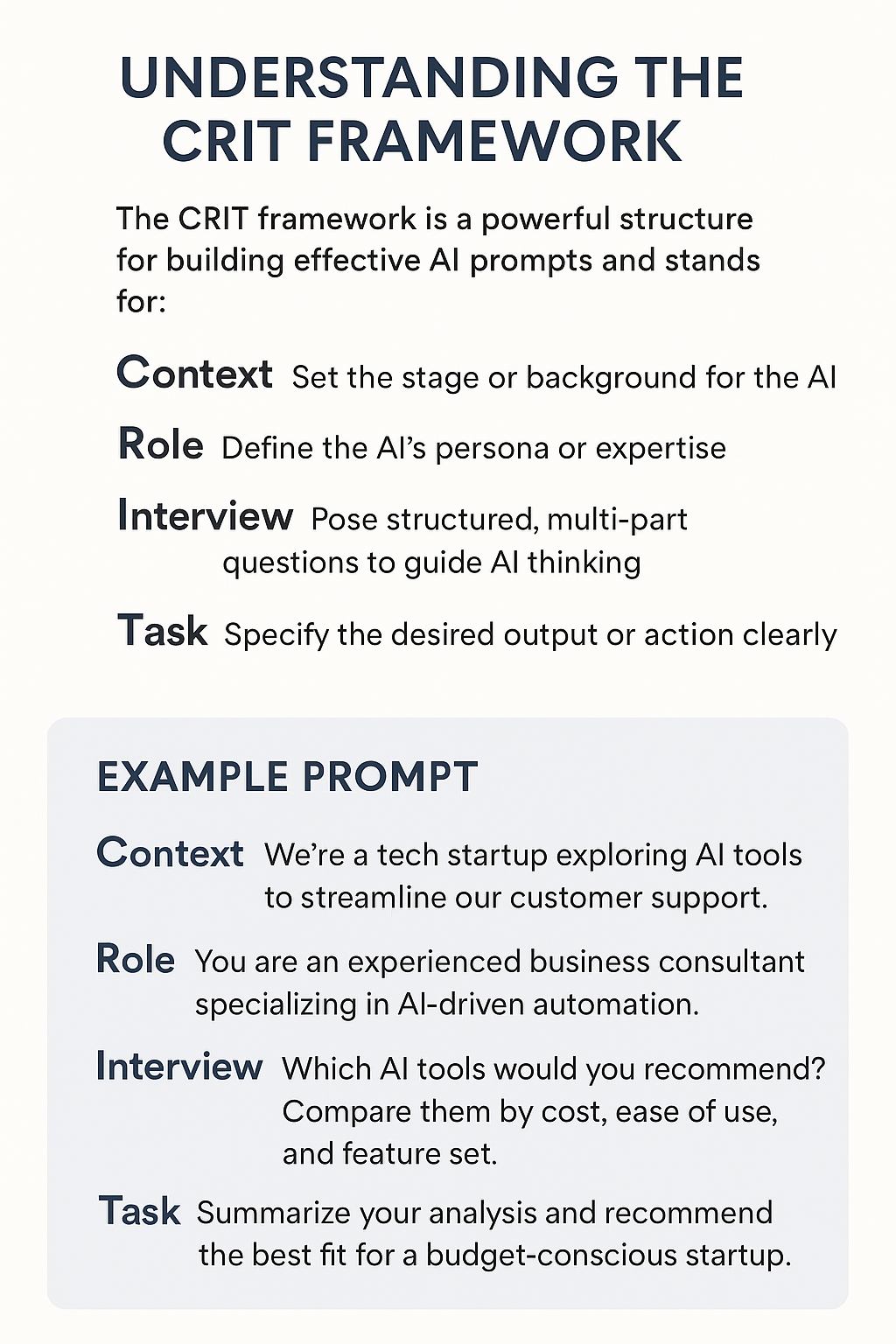
Turning Structured AI Prompts into Strategic Results
We’ve explored various prompt examples and seen how frameworks like RISE, RTF, BAB, CARE, and CRIT enable leaders to cut through ambiguity and drive results. By giving AI clear roles, context, and outcomes, these prompt frameworks empower executives to generate consistent, actionable outputs across tasks - from board updates to strategic planning.
The takeaway is simple: frameworks are a tried-and-true way to solve problems, and the same discipline applies to AI prompts. The more you experiment with different frameworks, the easier it becomes to apply the right structure to the right task - elevating AI from a passive assistant to a dependable partner in strategic decision-making.





.svg)






_0000_Layer-2.png)

